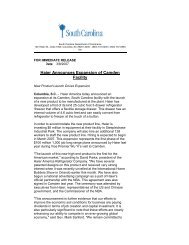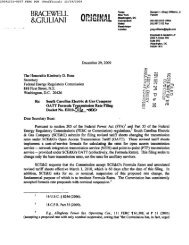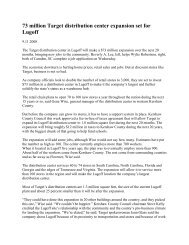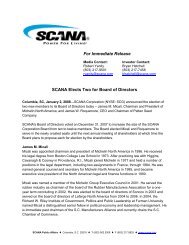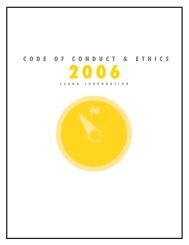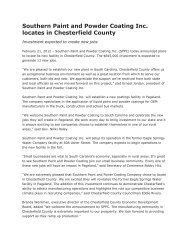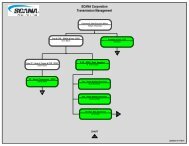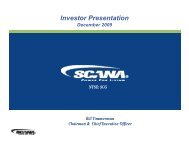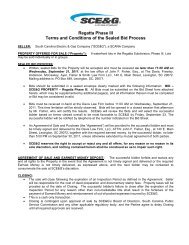10-K - SCANA Corporation
10-K - SCANA Corporation
10-K - SCANA Corporation
Create successful ePaper yourself
Turn your PDF publications into a flip-book with our unique Google optimized e-Paper software.
Table of Contents<br />
Air Quality<br />
With the pervasive emergence of concern over the issue of global climate change as a significant influence upon the<br />
economy, <strong>SCANA</strong>, SCE&G and GENCO are subject to climate-related financial risks, including those involving regulatory<br />
requirements responsive to GHG emissions, as well as those involving physical impacts which could arise from global climate change.<br />
Other business and financial risks arising from such climate change could also arise. The Company cannot predict all of the climaterelated<br />
regulatory and physical risks nor the related consequences which might impact the Company, and the following discussion<br />
should not be considered all-inclusive.<br />
From a regulatory perspective, <strong>SCANA</strong>, SCE&G and GENCO continually monitor and evaluate their current and projected<br />
emission levels and strive to comply with all state and federal regulations regarding those emissions. SCE&G and GENCO participate<br />
in the sulfur dioxide and nitrogen oxide emission allowance programs with respect to coal plant emissions and also have constructed<br />
additional pollution control equipment at several larger coal-fired electric generating plants. Further, SCE&G is engaged in preconstruction<br />
activities of the New Units which are expected to reduce GHG emission levels significantly once they are completed and<br />
dispatched by potentially displacing some of the current coal-fired generation sources.<br />
In 2005, the EPA issued the CAIR, which required the District of Columbia and 28 states, including South Carolina, to<br />
reduce nitrogen oxide and sulfur dioxide emissions in order to attain mandated state levels. CAIR set emission limits to be met in two<br />
phases beginning in 2009 and 2015, respectively, for nitrogen oxide and beginning in 20<strong>10</strong> and 2015, respectively, for sulfur dioxide.<br />
SCE&G and GENCO determined that additional air quality controls would be needed to meet the CAIR requirements. On July 6,<br />
2011 the EPA issued the CSAPR. This rule replaced CAIR and the Clean Air Transport Rule proposed in July 20<strong>10</strong> and is aimed at<br />
addressing power plant emissions that may contribute to air pollution in other states. CSAPR requires states in the eastern United<br />
States to reduce power plant emissions, specifically sulfur dioxide and nitrogen oxide. On December 30, 2011, the United States<br />
Court of Appeals for the District of Columbia issued an order staying CSAPR and reinstating CAIR pending resolution of an appeal of<br />
CSAPR. Air quality control installations that SCE&G and GENCO have already completed should assist the Company in complying<br />
with the CSAPR and the reinstated CAIR. The Company will continue to pursue strategies to comply with all applicable<br />
environmental regulations. Any costs incurred to comply with this rule or other rules issued by the EPA in the future are expected to<br />
be recoverable through rates.<br />
In June 20<strong>10</strong>, the EPA issued a final rule for a one-hour ambient air quality standard for sulfur dioxide. This new standard<br />
may require some of SCE&G’s smaller coal-fired units to reduce their sulfur dioxide emissions to a level to be determined by the EPA<br />
and/or DHEC. The costs incurred to comply with this new standard are expected to be recovered through rates.<br />
Physical effects associated with climate changes could include the impact of possible changes in weather patterns, such as<br />
storm frequency and intensity, and the resultant potential damage to the Company’s electric system, as well as impacts on customers<br />
and on the Company’s supply chain and many others. Much of the service territory of SCE&G is subject to the damaging effects of<br />
Atlantic and Gulf coast hurricanes and also to the damaging impact of winter ice storms. To help mitigate the financial risks arising<br />
from these potential occurrences, SCE&G maintains insurance on certain properties and has collected funds from customers for its<br />
storm damage reserve (see Note 2 to the consolidated financial statements). As part of its ongoing operations, SCE&G maintains<br />
emergency response and storm preparation plans and teams, and applicable personnel participate in ongoing training and related<br />
simulations in advance of such storms, all in order to allow the Company to protect its assets and to return its systems to normal<br />
reliable operation in a timely fashion following any such event.<br />
In December 2009, the EPA issued a final finding that atmospheric concentrations of GHG endanger public health and<br />
welfare within the meaning of Section 202(a) of the CAA. The rule, which became effective in January 20<strong>10</strong>, enables the EPA to<br />
regulate GHG emissions under the CAA. The EPA has committed to issue new rules regulating such emissions in 2012. The<br />
Company expects that any costs incurred to comply with GHG emission requirements will be recoverable through rates.<br />
In 2005, the EPA issued the CAMR which established a mercury emissions cap and trade program for coal-fired power<br />
plants. Numerous parties challenged the rule and, on February 8, 2008, the United States Circuit Court for the District of Columbia<br />
vacated the rule for electric utility steam generating units. In March 2011, the EPA proposed new standards for mercury and other<br />
specified air pollutants. The rule, which becomes effective on April 16, 2012, provides up to four years for facilities to meet the<br />
standards. The rule is currently being evaluated by the Company. Any costs incurred to comply with this rule or other rules issued by<br />
the EPA in the future are expected to be recoverable through rates.<br />
43



